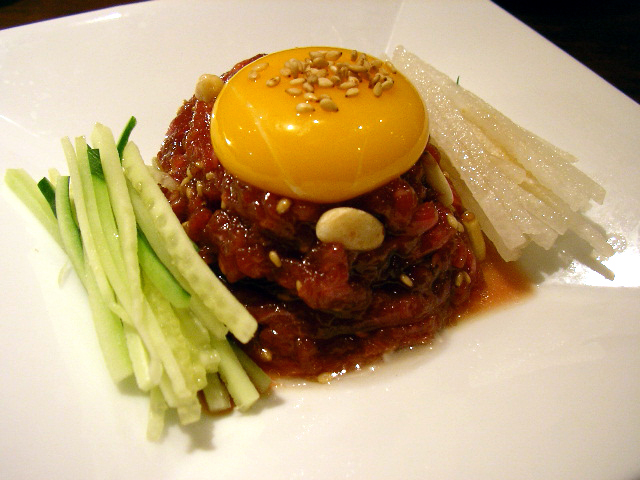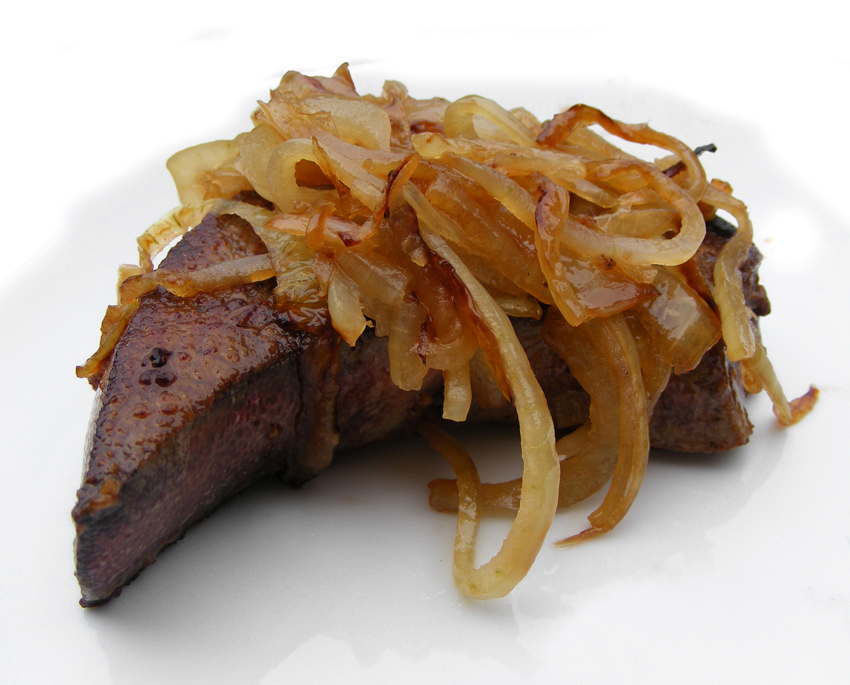|
Yukhoe
''Yukhoe'' ( ko, 육회 ) is a raw meat dish in Korean cuisine. It is most commonly made of beef but it can come in various kinds and cuts of meat. ''Yukhoe'' literally means 'raw (''hoe'', ) meat (''yuk'', )'. Therefore, in the strictest context, the term designates any dish of raw meat cut up for consumption without the marinade. But colloquially ''yukhoe'' means a dish of marinated raw beef slices. Though relatively rare to find these days, ''yukhoe'' can come in all kinds of meat. Yukhoe made of other meats will mention the source of the meat, for instance, a ''kkwong-yukhoe'' is made of pheasant, and a ''mal-yukhoe'' is made of horse meat. ''Yukhoe'' is most commonly made of lean cuts such as an eye of round, but more tender cuts of a beef can also be used. The beef is cut into thin strips while removing the fat, then it is seasoned with salt, sugar, sesame oil, pepper, and garlic. [...More Info...] [...Related Items...] OR: [Wikipedia] [Google] [Baidu] |
Steak Tartare
Steak tartare or tartar steak is a dish of raw ground (minced) beef. It is usually served with onions, capers, mushrooms, pepper, Worcestershire sauce, and other seasonings, often presented separately, to be added to taste. It is often served on top with a raw egg yolk. It is similar to the Levantine '' kibbeh nayyeh'', the Turkish ''çiğ köfte'', the Korean ''yukhoe'' and the widely known Japanese ''sashimi''. The name tartare is sometimes generalized to other raw meat or fish dishes. In France, a less-common variant called ''tartare aller-retour'' is a mound of mostly raw ground meat lightly seared on both sides. History The Tatars and raw meat A popular caricature of Mongol warriors—called Tatars or Tartars—has them tenderizing meat under their saddles, then eating it raw. This story was popularized by the French chronicler Jean de Joinville in the 13th century, although he never actually encountered Mongols himself and used the story as a way of showing t ... [...More Info...] [...Related Items...] OR: [Wikipedia] [Google] [Baidu] |
Korean Cuisine
Korean cuisine has evolved through centuries of social and political change. Originating from ancient agricultural and nomadic traditions in Korea and southern Manchuria, Korean cuisine reflects a complex interaction of the natural environment and different cultural trends. Korean cuisine is largely based on rice, vegetables, seafood and (at least in South Korea) meats. Dairy is largely absent from the traditional Korean diet. Traditional Korean meals are named for the number of side dishes (반찬; 飯饌; '' banchan'') that accompany steam-cooked short-grain rice. Kimchi is served at nearly every meal. Commonly used ingredients include sesame oil, ''doenjang'' (fermented bean paste), soy sauce, salt, garlic, ginger, '' gochugaru'' ( pepper flakes), ''gochujang'' (fermented red chili paste) and napa cabbage. Ingredients and dishes vary by province. Many regional dishes have become national, and dishes that were once regional have proliferated in different variat ... [...More Info...] [...Related Items...] OR: [Wikipedia] [Google] [Baidu] |
Chili Pepper
Chili peppers (also chile, chile pepper, chilli pepper, or chilli), from Nahuatl '' chīlli'' (), are varieties of the berry-fruit of plants from the genus ''Capsicum'', which are members of the nightshade family Solanaceae, cultivated for their pungency. Chili peppers are widely used in many cuisines as a spice to add "heat" to dishes. Capsaicin and related compounds known as capsaicinoids are the substances giving chili peppers their intensity when ingested or applied topically. While ''chili peppers'' are (to varying degrees) pungent or "spicy", there are other varieties of capsicum such as bell peppers (UK: peppers) which generally provide additional sweetness and flavor to a meal rather than “heat.” Chili peppers are believed to have originated somewhere in Central or South America. and were first cultivated in Mexico. After the Columbian Exchange, many cultivars of chili pepper spread around the world, used for both food and traditional medicine. This led to ... [...More Info...] [...Related Items...] OR: [Wikipedia] [Google] [Baidu] |
Capreolus Pygargus
The Siberian roe deer, eastern roe deer, or Asian roe (''Capreolus pygargus''), is a species of roe deer found in northeastern Asia. In addition to Siberia and Mongolia, it is found in Kazakhstan, the Tian Shan Mountains of Kyrgyzstan, eastern Tibet, the Korean Peninsula, and northern China. Its specific name ', literally "white-rumped", is shared by the pygarg, an antelope known in the antiquity. The name was chosen by the German biologist Peter Simon Pallas in the late 18th century. The roe deer has long antlers. Taxonomy The Siberian roe deer was once considered to be the same species as the European roe deer (''Capreolus capreolus''), but it is now considered to be separate. The two subspecies of Siberian roe deer are ''C. p. pygargus'' and ''C. p. tianshanicus'' (named for the Tian Shan mountains). Description The Siberian roe deer is a moderately sized metacarpalian deer, with a long neck and large ears. It is typically up to in body length and in weight, making it l ... [...More Info...] [...Related Items...] OR: [Wikipedia] [Google] [Baidu] |
Phasianus Colchicus
The common pheasant (''Phasianus colchicus'') is a bird in the pheasant family (Phasianidae). The genus name comes from Latin ''phasianus'', "pheasant". The species name ''colchicus'' is Latin for "of Colchis" (modern day Georgia), a country on the Black Sea where pheasants became known to Europeans. Although ''Phasianus'' was previously thought to be closely related to the genus ''Gallus'', the genus of junglefowl and domesticated chickens, recent studies show that they are in different subfamilies, having diverged over 20 million years ago. It is native to Asia and parts of Europe like the northern foothills of the Caucasus and the Balkans. It has been widely introduced elsewhere as a game bird. In parts of its range, namely in places where none of its relatives occur such as in Europe, where it is naturalised, it is simply known as the "pheasant". Ring-necked pheasant is both the name used for the species as a whole in North America and also the collective name for a number o ... [...More Info...] [...Related Items...] OR: [Wikipedia] [Google] [Baidu] |
Tendon As Food
The tendons of certain animals (particularly beef tendon) are used as an ingredient in some Asian cuisines, including the Filipino, Chinese, Japanese, Korean, Indonesian, Thai, Laotian, Cambodian and Vietnamese traditions. Tendon is tough and fibrous, but becomes soft after a long period of cooking. In some cases it may be boiled for as long as eight hours, while in other dishes it is prepared by deep frying. It contains large amounts of collagen, and after boiling or stewing, it is sometimes described as mimicking the mouthfeel of high-fat cuts of beef despite its low fat content. One author described the taste of deep-fried tendon as being similar to ''chicharrón'' (fried pork belly). Culinary uses China One popular Chinese dish is (), where the tendon is marinated in garlic; it is often served at '' dim sum'' restaurants. Indonesia In Indonesian cuisine, ''bakso'' is beef meatball filled with pieces of tendon, while '' soto'' is spicy cow's trotters soup which inclu ... [...More Info...] [...Related Items...] OR: [Wikipedia] [Google] [Baidu] |
Beef Shank
The beef shank is the leg portion of a steer or heifer. In the UK, the corresponding cuts of beef are the shin (the foreshank), and the leg (the hindshank). Due to the constant use of this muscle by the animal, it tends to be tough, dry, and sinewy, so is best when cooked for a long time in moist heat. It is an ideal cut to use for beef bourguignon. As it is very lean, it is widely used to prepare very low-fat ground beef. Due to its lack of sales, it is not often seen in shops. However, if found in retail, it is very cheap and a low-cost ingredient for beef stock. Beef shank is a common ingredient in soups. In Australia, it is commonly sold from butchers as ''gravy beef'' for bone-less shanks or as '' osso buco'' with bone-in. In Asia, braised beef shank is very popular. See also * List of steak dishes This is a list of steak dishes. Steak is generally a cut of beef sliced perpendicular to the muscle fibers, or of fish cut perpendicular to the spine. Meat steak ... [...More Info...] [...Related Items...] OR: [Wikipedia] [Google] [Baidu] |
Tripe
Tripe is a type of edible lining from the stomachs of various farm animals. Most tripe is from cattle, pigs and sheep. Types of tripe Beef tripe Beef tripe is made from the muscle wall (the interior mucosal lining is removed) of a cow's stomach chambers: the rumen (blanket/flat/smooth tripe), the reticulum (honeycomb and pocket tripe), and the omasum (book/bible/leaf tripe). Abomasum (reed) tripe is seen less frequently, owing to its glandular tissue content. Other animals Tripe refers to cow (beef) stomach, but includes stomach of any ruminant including cattle, sheep, deer, antelope, goat, ox, giraffes, and their relatives. , the related Spanish word, also refers to culinary dishes produced from any animal with a stomach. In some cases, other names have been applied to the tripe of other animals. For example, tripe from pigs may be referred to as ''paunch'', ''pig bag'', or ''hog maw''. Washed tripe Washed tripe is more typically known as dressed tripe. To dress th ... [...More Info...] [...Related Items...] OR: [Wikipedia] [Google] [Baidu] |
Abomasum
The abomasum, also known as the maw,The Chambers Dictionary, Ninth Edition, Chambers Harrap Publishers, 2003 rennet-bag, or reed tripe, is the fourth and final compartment in . It secretes , which is used in creation. The word ''abomasum'' (''ab-'' "away from" ... [...More Info...] [...Related Items...] OR: [Wikipedia] [Google] [Baidu] |
Kidney (food)
The kidneys are two reddish-brown bean-shaped organs found in vertebrates. They are located on the left and right in the retroperitoneal space, and in adult humans are about in length. They receive blood from the paired renal arteries; blood exits into the paired renal veins. Each kidney is attached to a ureter, a tube that carries excreted urine to the bladder. The kidney participates in the control of the volume of various body fluids, fluid osmolality, acid–base balance, various electrolyte concentrations, and removal of toxins. Filtration occurs in the glomerulus: one-fifth of the blood volume that enters the kidneys is filtered. Examples of substances reabsorbed are solute-free water, sodium, bicarbonate, glucose, and amino acids. Examples of substances secreted are hydrogen, ammonium, potassium and uric acid. The nephron is the structural and functional unit of the kidney. Each adult human kidney contains around 1 million nephrons, while a mouse kidney contains ... [...More Info...] [...Related Items...] OR: [Wikipedia] [Google] [Baidu] |
Liver (food)
The liver of mammals, fowl, and fish is commonly eaten as food by humans (see offal). Pork, lamb, veal, beef, chicken, goose, and cod livers are widely available from butchers and supermarkets while stingray and burbot livers are common in some European countries. Animal livers are rich in iron, copper, the B vitamins and preformed vitamin A. Daily consumption of liver can be harmful; for instance, vitamin A toxicity has been proven to cause medical issues to babies born of pregnant mothers who consumed too much vitamin A. A single serving of beef liver exceeds the tolerable upper intake level of vitamin A. 100 g cod liver contains 5 mg of vitamin A and 100 µg of vitamin D. Liver contains large amounts of vitamin B12, and this was one of the factors that led to the discovery of the vitamin. Etymology From Middle English liver, from Old English , from Proto-Germanic , from Proto-Indo-European "to smear, smudge, stick", from Proto-Indo-European - "to be ... [...More Info...] [...Related Items...] OR: [Wikipedia] [Google] [Baidu] |




.jpg)


